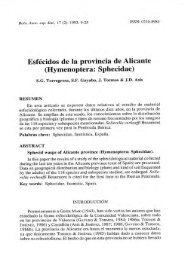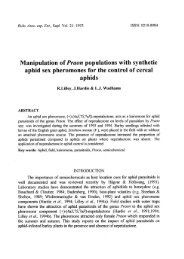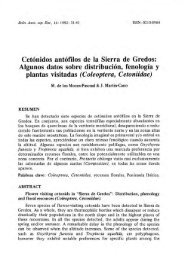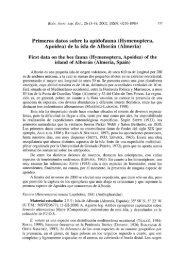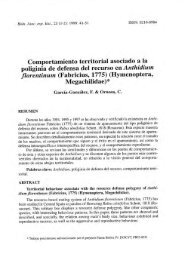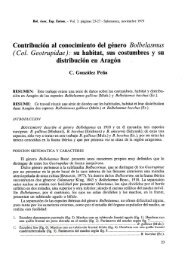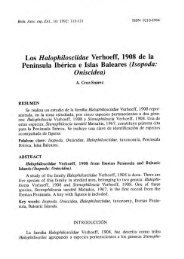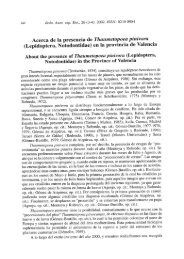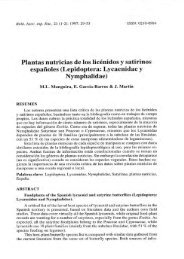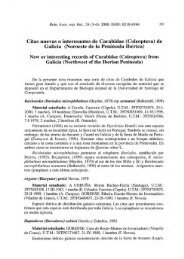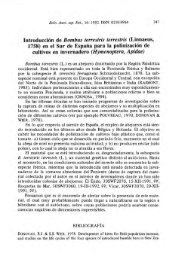Libro 1.indb
Libro 1.indb
Libro 1.indb
Create successful ePaper yourself
Turn your PDF publications into a flip-book with our unique Google optimized e-Paper software.
GALL MIDGES (DIPTERA: CECIDOMYIIDAE) OF THE IBERIAN PENINSULA 133<br />
southwards up to Iberian Peninsula where usually run the southern boundary<br />
of their distribution area. Typical representatives of European species<br />
are Hartigiola annulipes and Mikiola fagi causing galls on leaves of Fagus<br />
sylvatica, and Macrodiplosis pustularis and M. roboris causing galls on<br />
leaves of Quercus robur and Q. petraea. Five species associated with Cytisus<br />
(Sarothamnus) scoparius, viz. Asphondylia sarothamni, Contarinia scoparii,<br />
Dasineura tubicoloides, Jaapiella sarothamni and Janetiella tuberculi, are<br />
European and sub-Atlantic species occurring abundantly along the seaside,<br />
penetrate inland and reach with its host plant eastwards up to the Czech<br />
Republic.<br />
Kochiomyia kochiae is the Pontic-Pannonian species causing galls on<br />
Bassia prostrata (= Kochia prostrata). It occurs abundantly along the seaside<br />
of the Black Sea (Pontus Euxinus) and in the Pannonian lowlands in<br />
Hungary (SKUHRAVÁ & SKUHRAVÝ, 1999). The galls were found also<br />
in southern France and in north-eastern Spain where this species reaches<br />
the most western limits of its remarkable distribution area.<br />
Forty five species (17%) may be regarded as Euro-Siberian. They occur<br />
abundantly in Europe, extending at least to Western Siberia and few<br />
species reach up to the eastern part of Palaearctic Region, to the Far East,<br />
China and Japan. Typical representatives are Harmandiola cavernosa and H.<br />
globuli associated with Populus tremula, Lasioptera rubi on various species<br />
of Rubus, Iteomyia capreae on Salix caprea and, S. aurita and Contarinia<br />
tiliarum causing galls on young shoots of Tilia cordata and T. platyphyllos.<br />
Most of Euro-Siberian species reach the southern limits of distribution area<br />
in Iberian Peninsula.<br />
Two species, viz. Etsuhoa sabinae and Xerephedromyia ustjurtensis, have<br />
disjuncted Euro-Asian areas of distribution. Galls of Etsuhoa sabinae on<br />
Juniperus sabina occur rarely in mountains of Europe and were also found<br />
in mountains of eastern Kazakhstan. Galls of Xerephedromyia ustjurtensis on<br />
Ephedra distachya were discovered in western Kazakhstan near the Caspian<br />
Sea, in northern Spain and southern France. Such type of distribution may<br />
be denominated as Mediterraneo-Turanian.<br />
Two other species, viz. Peromyia truncata and Polyardis bispinosa, belonging<br />
to the subfamily Lestremiinae, have Palaearctic distribution. Adults<br />
were caught rarely in Europe and in Asia (Far East, Japan).<br />
Mediterrenean and sub-Mediterranean species are the largest group including<br />
about 110 species (43%). They occur abundantly in the Mediterranean,<br />
some of them penetrate with their host plants northwards and few species<br />
reach even up to Central Europe. These are usually called sub-Mediterranean<br />
species. Phyllodiplosis cocciferae and Dryomyia cocciferae causing<br />
galls on Quercus coccifera, four species associated with Quercus ilex, viz.<br />
Boln. Asoc. esp. Ent., 30 (1-2): 93-159, 2006



